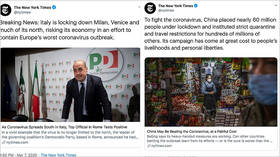Uber is LYING to drivers about how much customers pay for rides, San Francisco news outlet claims
Uber has been giving its drivers in San Francisco the wrong figures for how much their riders pay, apparently understating the share of the money the company keeps for itself, a local news platform has reported.
The anecdotal account indicating a possible squeeze of drivers by the company came from Mission Local, an independent local news site based in SF’s Mission District. It said it found discrepancies between what its journalist paid for rides and what their drivers were told about the fare by the Uber app. It came up as the reporter was researching how the company and its competitor Lyft split fares with drivers.
We booked 20 rides in SF with drivers who shared their pay for our trips. The unscientific sampling showed that drivers took home an average of 52% of our fares.What's more, the amount Uber told drivers we paid was around 20% less than our actual fares.https://t.co/oC44aW3cz3
— Mission Local (@MLNow) July 15, 2021
The outlet booked a total of 20 rides, 10 with each gig company, and asked drivers to share how much they received for the service. In five out of five Uber rides where the driver agreed to show a breakdown of his pay, the app showed as “customer price” a sum smaller than what was actually paid. The real price was 9.6% to 26.3% higher than what the driver was told it was, the report said.
Uber didn’t explain the discrepancy, when asked for comment by the outlet.
There was no comparable data for Lyft rides, as the company shows only how much a ride would earn the driver. It said a breakdown of individual rides could be misleading.
Mission Local’s unscientific – as it stressed – study of the gig-riding compensation structure came shortly after a report by the Washington Post, which said Uber and Lyft drivers were not enjoying the surge in earnings one would expect to follow an increase in ride prices caused by a workforce shortage.
The story particularly focused on California, where drivers used to get a percentage of the fare, helping the companies argue that gig workers were independent contractors and not their employees, who should receive all relevant benefits. The necessity for this special treatment was removed last year, after the state passed Proposition 22, a ballot initiative that settled the legal status in the organizations’ favor. Gig companies had spent some $200 million to promote Proposition 22 to voters in the Golden State.
Also on rt.com Covid crisis caused wealth inequality & created millions of new millionaires – Credit SuisseUber has since realigned its compensation scheme in California to match how it works in all other states in the US. Drivers get paid depending on the distance and the time a trip takes, and may also receive a fixed bonus when accepting a ride during a price surge.
Its CEO, Dara Khosrowshahi, disputed the newspaper’s narrative, saying in a Twitter thread that drivers’ pay per trip had increased by 37% nationwide between January and May. He added that, in California, the increase had been even bigger, and defended the decoupling of driver payments from fares as an attempt to “match supply & demand more efficiently per trip.”
1/ Yesterday I read the following headline from the @washingtonpost: “You may be paying more for Uber, but drivers aren’t getting their cut of the fare hike.” This alarmed me so I called my team - I knew this wasn’t true but wanted to be sure.
— dara khosrowshahi (@dkhos) June 11, 2021
Pre-Proposition 22, Uber kept a 25% or 28% service fee, depending on the type of ride, according to its corporate blog. Now it gets a variable share that “equals what the rider pays minus what the driver earns”. Mission Local said that, in its small sample, drivers with Uber averaged 56% of what the reporter paid for rides. For Lyft drivers, the figure was 47%.
If the city fee was taken into account, Uber “pocketed an average and a median of 42 percent in the trips I took,” the reporter, David Mamaril Horowitz, wrote.
Uber regional public affairs representative Zahid Arab told the outlet: “Uber’s median take rate has remained the same,” or around 25%.
Like this story? Share it with a friend!














